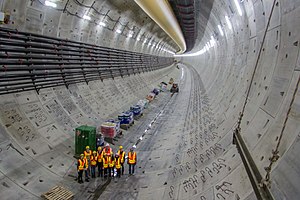| Bertha | |
|---|---|
 Front of a model of Bertha at Milepost 31, the tunnel project information center | |
| Classification | Tunnel boring machine |
| Application | State Route 99 tunnel |
| Dimensions | Length: 326 feet (99 m) Diameter: 57.5 feet (17.5 m) |
| Weight | 6,700 short tons (6,100 t) |
| Powered | |
| Cost | $80 million |
| Launched | July 30, 2013 |
| Disassembled | August 2017 |
Bertha was a 57.5-foot-diameter (17.5 m) tunnel boring machine built specifically for the Washington State Department of Transportation's (WSDOT) Alaskan Way Viaduct replacement tunnel project in Seattle, Washington, United States.[2] It was made by Hitachi Zosen Sakai Works in Osaka, Japan, and the machine's assembly was completed in Seattle in June 2013. Tunnel boring began on July 30, 2013, with the machine originally scheduled to complete the tunnel in December 2015.
On December 6, 2013, work was halted approximately 1,083 feet (330 m) into the planned 9,270-foot-long (2,830 m) route because of an unexpected impediment. It was thought that several cutting blades were damaged by striking a steel pipe that had been used to measure groundwater in 2002 around the Alaskan Way Viaduct. However, subsequent investigation revealed that portions of the main bearing seal system were damaged, causing the bearing to overheat during operation.[3] Over the next two years, a recovery pit was dug from the surface in order to access and lift the machine's cutterhead for repair and partial replacement in 2015.

Bertha resumed tunnel boring on December 22, 2015, but was stopped in early January 2016 after a tethered barge in Elliott Bay damaged nearby piers and a sinkhole opened near the project site. Governor Jay Inslee halted all work on the tunnel on January 14, 2016, citing concern over public safety after the sinkhole incident. Digging briefly resumed on February 23, but was halted again for maintenance and inspections before resuming full operations on April 29.[4]
In December 2015, WSDOT had estimated that the tunnel would be completed and open to traffic in early 2018.[5] The estimate was revised in July 2016 to open in early 2019 with an estimated $223 million in cost overruns stemming from the two-year delay.[6] Tunnel boring was completed on April 4, 2017, with Bertha's cutterhead breaking through into a disassembly vault at the tunnel's north portal in South Lake Union.[7] The final disassembled pieces of the boring machine were removed in August 2017, and the finished tunnel opened to traffic on February 4, 2019. Bertha's components were not reusable and were scrapped.
- ^ a b "Bertha's 9,270-ft Journey Under Seattle for SR 99". TBM News.
- ^ "Tunneling toward a new SR 99". Washington State Department of Transportation. 2012. Archived from the original on December 10, 2012. Retrieved May 19, 2015.
- ^ Newcomb, Tim (February 10, 2014). "Damaged Main Bearing Seals Cause of Bertha Overheating, Shutdown". Engineering News-Record. Retrieved April 4, 2017.
- ^ Demay, Daniel (April 29, 2016). "Bertha inches ahead, viaduct closure begins, traffic slows". Seattle Post-Intelligencer. Retrieved April 30, 2016.
- ^ Lindblom, Mike (January 4, 2016). "Tunnel machine Bertha expected to bust out of vault this week". The Seattle Times. Retrieved January 4, 2016.
- ^ Lindblom, Mike (July 21, 2016). "Bertha's woes grind on: more delay, higher cost for Highway 99 tunnel". The Seattle Times. Retrieved July 21, 2016.
- ^ Lindblom, Mike (April 4, 2017). "Bertha's breakthrough just 'halftime' for tunnel project". The Seattle Times. Retrieved April 6, 2017.